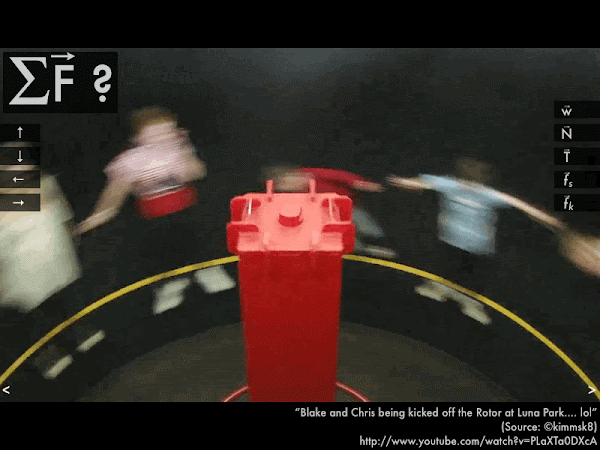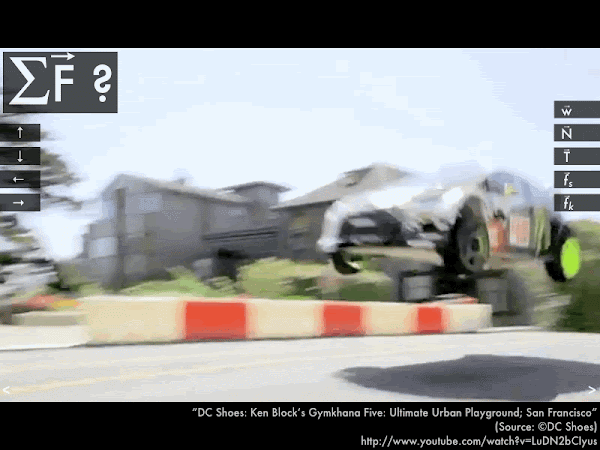Cuesta College, San Luis Obispo, CA
Students have a bi-weekly online reading assignment (hosted by SurveyMonkey.com), where they answer questions based on reading their textbook, material covered in previous lectures, opinion questions, and/or asking (anonymous) questions or making (anonymous) comments. Full credit is given for completing the online reading assignment before next week's lecture, regardless if whether their answers are correct/incorrect. Selected results/questions/comments are addressed by the instructor at the start of the following lecture.
The following questions were asked on reading textbook chapters and previewing a presentation on uniform circular motion.

Selected/edited responses are given below.
Describe what you understand from the assigned textbook reading or presentation preview. Your description (2-3 sentences) should specifically demonstrate your level of understanding.
"Uniform circular motion is a Newton's second law case because the direction is changing, and that the net force must point towards the center."
"Circular motion is covered by Newton's second law. In order to maintain constant speed along a circular trajectory, with acceleration directed in towards the center, the net force must be exactly equal to m·v2/r, and be directed in towards the center."
"Newton's second law applies to uniform circular motion. Even as the direction is continuously changing, the acceleration always points inward towards the center."
"The 'centripetal force' is basically the net force that is required to keep an object moving in a circular motion, in where this net force is always pointed toward the center of the circle. The 'centrifugal force' is 'fictitious force' of sorts which appears to be acting on an object when really it is not. It is essentially Newton's third law in that for every action you have an equal and opposite reaction."
"'Centripetal' force means 'center-seeking' which describes a net force that is always pointing inward. 'Centrifugal force' means 'center-fleeing.'"
"I have some understanding of what we went over in class, but from the reading I have very little understanding of what is going on."
"I have not gotten to this yet, though I did spend a lot of time on our last section, reviewing and learning the problems."
"I have yet to read it because I have an organic chemistry test tomorrow."
Describe what you found confusing from the assigned textbook reading or presentation preview. Your description (2-3 sentences) should specifically identify the concept(s) that you do not understand.
"I find the concept of 'centrifugal force' more abstract than the type of forces we have gone over so far."
"I didn't understand 'centrifugal force' and how it's different from 'centripetal force.'"
"I got a little confused on the explanation of 'centrifugal force' being fictitious. I wasn't sure if this was saying that there is no outwards force."
"For the example scenarios you put up, I'm confused in which direction some of the net forces acting on the objects are. For example, are we to conclude that the car drifting around the track in a constant circular motion would be considered a Newton's second law case (because although speed is constant our direction is always changing) and so the net force would point to the right (towards the center of the circle)? Could some of our net force forces point in the opposite direction as to the direction the object appears to be moving? I'm a little confused on that."
"It's hard for me to conceptually and visually understand that acceleration (and net force) points inwards during circular motion. Could you please illustrate this with a drawing in class? All makes sense."
"Nothing here really! :)"
"I feel good about these concepts."
"I found most of it confusing."

first; is zero. *** [3] second; points to the left. ********** [10] second; points to the right. ************************ [24] (Unsure/lost/guessing/help!) *** [3]

first; is zero. ******** [8] second; points upwards. ***************** [17] second; points downwards. ******** [8] (Unsure/lost/guessing/help!) ******* [7]

first; is zero. *** [3] second; points to the left. ************* [13] second; points to the right. ******************** [20] (Unsure/lost/guessing/help!) **** [4]

first; is zero. ***** [5] second; points upwards. ******** [8] second; points downwards. *********************** [23] (Unsure/lost/guessing/help!) **** [4]

first; is zero. ****** [6] second; points to the left. ***************** [17] second; points to the right. ********** [10] (Unsure/lost/guessing/help!) ******* [7]

first; is zero. ******* [7] second; points upwards. **** [4] second; points downwards. ********************** [22] (Unsure/lost/guessing/help!) ******* [7]

first; is zero. ****** [6] second; points upwards. ***** [5] second; points downwards. ************************* [25] (Unsure/lost/guessing/help!) **** [4]
Ask the instructor an anonymous question, or make a comment. Selected questions/comments may be discussed in class.
"Centripetal force is a very cool concept! I went on YouTube and easily spent about an hour looking at different related videos!"
"So during the loop-the-loop stunt, the weight won't always affect it the same way, why is that? Would the gravitational pull change?" (No, the weight force of Earth on the object can't ever change, no matter what the object's motion is like. However, the normal force of the track on the object (if/when it is contact with the track) can change, as that is a variable force.)
"Honestly, what confused me the most was how that small girl was swinging that man by the foot in one of the presentation slides. She definitely did not have the appearance of an Olympic discus thrower." (That man is Li Wei, a performance artist that specializes in wire work stunt photography.)
"I am not totally clear about the net forces and direction, the acceleration a = v2/r always pointing towards the center (or else constant speed in a straight line), and horizontal and vertical components (e.g. if the string breaks, then there would be no inwards net force, and no uniform circular motion, such that the donut undergoes free fall--subject to Newton's second law vertically, but Newton's first law horizontally, and thus would be seen moving in a straight line." (Sounds to me like you are pretty clear on this topic.)
No comments:
Post a Comment